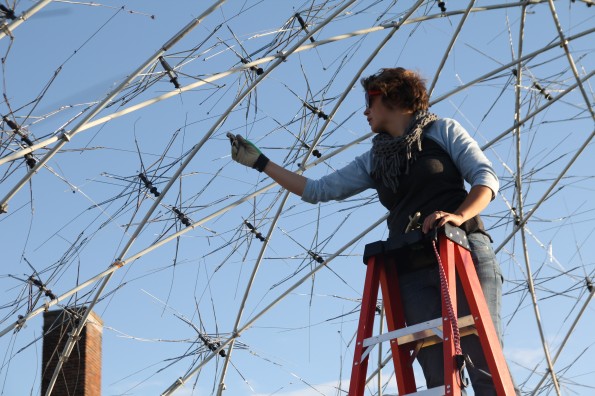
A volunteer puts finishing touches on a sculpture made of broken umbrellas in Hunts Point. (CELIA LLOPIS-JEPSEN/Bronx Ink)
New York architect Amanda Schachter’s giant floating sculpture “Harvest Dome” was meant to float peacefully on Manhattan’s last remaining stretch of natural shoreline in Inwood, rising and falling with the four-foot tide to signal the cycle of nature breaking down detritus.
Schachter did not, however, intend for nature quite literally to destroy the 24-foot-diameter structure, which is what happened last week when the sculpture died a premature death on the treacherous rocks of Riker’s Island en route from the site of its creation at Rocking the Boat in Hunts Point to its would-be home at Inwood Hill Park.
Schachter and her two partners, her architect-husband Alexander Levi and metal fabricator Robert Wrazen, spent six months planning, building and applying for permits from the Department of Environmental Protection and the Department of Parks to create Harvest Dome, a see-through frame of pipes and abandoned, broken umbrellas “harvested” from New York’s streets that were floating on a rim of empty, discarded two-liter soda bottles.
The team received a $5,000 grant from the Lower Manhattan Cultural Council for the project, the goal of which was to highlight Manhattan’s last salt marsh, a terrain once common in New York. Over the decades, the city has traded natural shoreline for widened waterways lined with concrete. In the process it lost its salt marshes, a key habitat that cleanses the rivers of sewage.
“Now people are looking at these ecologies and trying to bring them back,” Schachter said last Wednesday on the way to Riker’s Island to pick up the torn remains of her dome from prison authorities.
After building the dome with the help of local volunteers and students participating in a city-sponsored youth employment program, the team moved the finished sculpture by crane from the yard of Rocking the Boat on the Bronx River to the water and began the slow haul by motorboat down the river, across the East River and up the Harlem River. The sculpture barely completed the first leg of the journey before the troubles began.
“Things got a little chaotic,” Schachter said. It was a windy day, and waves began hitting the boat and sculpture on the East River. When water began entering the motorboat, the captain cut the rope towing the dome. Currents swept the sculpture toward the jagged cliffs of Riker’s Island almost immediately.
“There was nothing we could do,” Schachter said. “We were sort of helpless.”
When Schachter went last week to pick up the dome from prison authorities, she found a pile of metal scraps and bottles that barely resembled her creation. Surveying the wreckage, she struggled to pull out a few cords that could be reused, and picked up a single two or three-foot length of pipe with the spiky, warped umbrella frame still attached. A souvenir.
“It’s a trash heap,” said Schachter, who had hoped to find the dome in better condition. “There’s nothing left to salvage.”
Prison authorities said the sharp rocks made short work of the dome when a crew dragged the sculpture from the water.
“I think the difficulty was accepting the fact that this happened so quickly,” she said. “It happened in an instant. The line was cut and we lost it.”
Schachter, Levi and Wrazen are determined to start anew next summer. The dome is gone, but Inwood’s salt marsh isn’t.
“We realized that we had learned so much making this and it was such a beautiful thing that we really had to make it again.”
